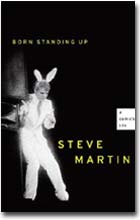Books |
Steve Martin: Born Standing Up
By
Published: Sep 06, 2022
Category:
Memoir
The “wild and crazy” guy. The goofball in the white suit, banjo optional. The comic with an arrow through his head. “King Tut”.
That goofball is now 77.
You open Steve Martin’s 2007 memoir expecting a laugh a paragraph.
Instead, you get repressed tears, intellectual curiosity, a phenomenal learning curve — a taut, not-a-word-wasted masterpiece that charts the making and deliberate unmaking of a stand-up comic.
Happily, Steve Martin avoids pathos; he’s a dry, precise, witty-after-the-fact writer. And he well understands a hoary show business cliché: Always leave ’em wanting more. “Born Standing Up” runs, with large print and photos, just 204 pages.
If it leaves out so many people, movies and personal interests that some readers will feel cheated, too bad for them. Because this isn’t one more late-life star cash-in, with just enough revelations to get the greedy, cynical celeb a round on Oprah and the morning shows. This short memoir is really about how Steve Martin saved his own life. It’s about making magic out of nothing much — literally. It’s an exploration of the source of art, which is, for Steve Martin, as for so many creators, about confronting and then escaping personal pain. [To buy the paperback from Amazon, click here. For the Kindle edition, click here.]
So, no surprise, Martin starts with his childhood. His father wanted to be an actor, so he moved his wife and two children from Waco, Texas to Hollywood in 1950. He didn’t make it, was forced to work in real estate to support his family, and became withdrawn, sullen and enraged. His son withdrew — and was beaten, one time seriously, for his “attitude.” Martin notes that “a complicated childhood can lead to a life in the arts. I tell you this story of my father and me to let you know I am qualified to be a comedian.”
He lived two miles from Disneyland. He was interested in magic, and at Disneyland, where he worked from the age of 10, he got a chance to watch and learn. Later, he demonstrated tricks eight to twelve hours a day — think he improved? He moved on, hung out with hipsters, decided to create an “avante-garde” comedy act, though he had only the dimmest idea what that was.
It turned out to be jokes without punchlines, stories that built tension that never got released. Audiences didn’t laugh. The waitresses did. Backstage in Vegas, Elvis gave him a spot-on review: “Son, you have an ob-leek sense of humor.” Martin pressed on.
Suddenly, after fourteen years, he was famous. And rich. But was he happy? Not really. And he did suffer silently, repeating the known jokes and banking the applause and money? Not at all.
And that’s the great revelation about Steve Martin. What he does may sound and look stupid — but it’s art. That is, his work speaks specifically to his time. And then it pushes the audience to fresh perceptions about the world we live in.
Memoirs about the “glory years” usually emphasize the struggle — the way up is, for most, a better story than the arrival. Steve Martin, true to his comedic style, twists that formula. Instead of giving us just the anecdotes, he dives inside and traces his intellectual growth. By the end of the book, when he sits by his dying father’s bedside, we are privileged to know the person that stars so rarely reveal: the man inside.


